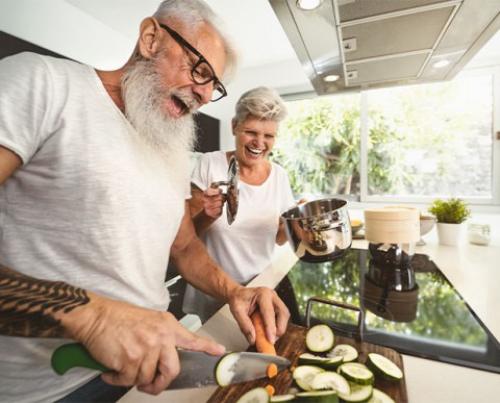Downward Trend in Senior Diet Quality
Older adults are the fastest-growing population sector in the United States. By 2060, this geriatric population will more than double and comprise almost one-fourth of the total U.S. population. A poor diet is a significant risk factor for chronic diseases, frailty, and disability, especially for the elderly. A study published recently in JAMA Network surveyed approximately 11,000 individuals aged 65 or older using a 24-hour dietary recall interview plus a post recall questionnaire designed to estimate the total intake of calories, nutrients, and non-nutritive components from foods and beverages consumed the day before. The study concluded that, despite rising educational and income levels, dietary quality has decreased among older adults in the years evaluated. What are they doing wrong? Let’s break it down by the individual food components measured.
Breaking Down the Results
The American Heart Association (AHA) Diet Score and the Healthy Eating Index (HEI) are measures of diet quality. In a nutshell (no pun intended), they both look at the types of food eaten to assess quality. ‘Good foods’ are fruits and vegetables, whole grains, fish and shellfish, nuts, greens and beans, dairy, plant and animal proteins, and fatty acids. ‘Bad foods’ include sugar-sweetened beverages, refined grains, sodium, added sugar, saturated fats, and processed meats. AHA diet scores and HEI were compared from 2001-2002 to 2017-2018. In both instances, dietary quality declined significantly.
Breaking the ADA diet scores down further, the total consumption of fruits and vegetables decreased (3.90 to 2.49 servings/day), as did nuts, seeds, and legumes (0.37 to 0.31 servings/day). On the upswing were the consumption of sugar-sweetened beverages (4.37 to 4.50 servings/day), processed meats (0.40 to 0.42 servings/day), and saturated fats (0.36 to 0.40 servings/day). The mean consumption of fish and shellfish increased from 0.23 to 0.27 servings per day.
Individual components of the HEI showed similar trends to ADA diet scores. Total protein foods, seafood, plant proteins, and added sugar increased significantly between 2001-2001 and 2017-2018. Except for white potatoes, all components in the fruit and vegetable category showed a decreasing trend.
The study divided the participant’s diets into three categories: poor, intermediate, and ideal. The proportion of seniors with poor diet quality increased from 51% to 61%, a significant 10% rise. The intermediate diet consumers dropped by 10%, and those with ideal diets remained low, an abysmal 0.4% of the total surveyed population. Because they are eating fewer fruits and vegetables and consuming more foods high in fat and sugar, over half of the seniors surveyed risk developing diabetes, heart disease, osteoporosis, high blood pressure, and hypertension. A poor diet can also lead to a weakened immune system, mental decline, and an overall lack of energy. How can we turn this looming health crisis around?
Steps to Better Elder Nutrition
There are many complex issues surrounding poor eating behavior in older adults. Food insecurity, social isolation, mobility issues, food deserts, racial disparities, lower education levels, and loneliness contribute to this trend. Healthy diets do cost more than unhealthy ones. The low cost of empty calorie foods compared to the higher cost of nutrient-rich foods points to social inequalities in dietary health.
The National Institute on Aging has recommendations for making healthy foods choices that will improve the quality of life for older Americans. Here are a few of their suggestions:
- Water, water everywhere! Drink lots of water. As people age, they lose their sense of thirst. Coffee is not a substitute for water. In fact, coffee is a diuretic, which means it causes the drinker to urinate more and actually lose water. Drink fewer sugar-sweetened beverages in favor of water or low-fat milk (a good source of calcium). Carry a bottle of water and drink often.
- Make eating a social event. Many seniors are isolated and alone. Some cannot travel easily due to mobility issues such as needing a walker or wheelchair. If you have an older parent, relative, or friend, make the effort to eat with them or take them out for a social dinner. Older adults may not enjoy eating as much as they used to. A social event makes a meal more pleasurable.
- Know how much to eat. You don’t always have to finish your plate. Save some for later. Leftovers save money and are as healthy as the original dish.
- Vary your vegetables. Use color as a guide. Vegetables are a low-calorie source of fiber, antioxidants, vitamins, and minerals.
- Eat for your teeth and gums. Changes in the mouth can make hard or crunchy foods difficult to eat for older Americans. Try softer versions of the same foods, such as canned or pureed options. If you can’t chew it, put it in a blender first!
- Enliven foods with herbs and spices. The senses of taste and smell are diminished in older adults. Medicines can also interfere with these senses. Salt is a flavor enhancer but will increase the meal's sodium content. Improve flavors by adding herbs and spices, juices, and seasonings.
- Ask your doctor or nutritionist about vitamins or supplements. Some health conditions can be improved by supplementation with vitamins and/or minerals. High-protein drinks are available for seniors who need higher density foods but have trouble chewing or swallowing. These are to be given with meals and not as substitutes for meals.
We Can All Help
If you are not yet a senior, take the time to help an elderly family member or friend. Become involved in their daily routine. What are they eating? What are the reasons they don’t eat better? Some seniors need a ride to the grocery store. Some would prefer not to eat alone. Some need help in the kitchen. Bring them fresh fruits and vegetables. Take them to a church dinner, social potluck, or a favorite restaurant. Buy them a water bottle and tell them to drink up. A little attention to diet and nutrition can enhance their quality of life, prevent a big medical bill, and thwart disease and depression during their golden years.
Sources: Trends in Diet Quality Among Older US Adults From 2001 to 2018 JAMA Network Open DOI: 10.1001/jamanetworkopen.2022.1880
Choosing Healthy Meals as You Get Older NIH: National Institute on Aging, April 29, 2019.





